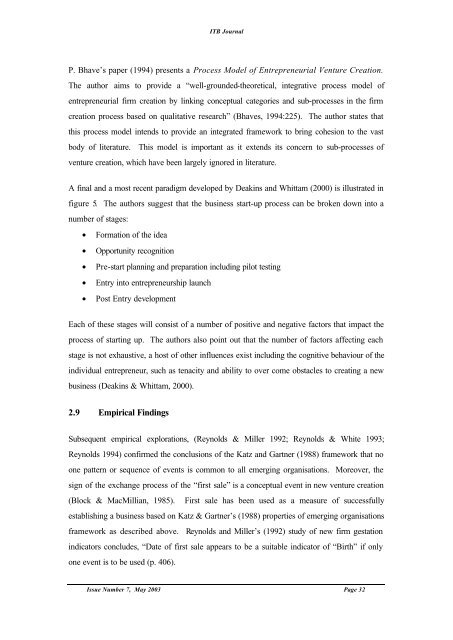ITB Journal-May-2003 - Institute of Technology Blanchardstown
ITB Journal-May-2003 - Institute of Technology Blanchardstown
ITB Journal-May-2003 - Institute of Technology Blanchardstown
Create successful ePaper yourself
Turn your PDF publications into a flip-book with our unique Google optimized e-Paper software.
<strong>ITB</strong> <strong>Journal</strong><br />
P. Bhave’s paper (1994) presents a Process Model <strong>of</strong> Entrepreneurial Venture Creation.<br />
The author aims to provide a “well-grounded-theoretical, integrative process model <strong>of</strong><br />
entrepreneurial firm creation by linking conceptual categories and sub-processes in the firm<br />
creation process based on qualitative research” (Bhaves, 1994:225). The author states that<br />
this process model intends to provide an integrated framework to bring cohesion to the vast<br />
body <strong>of</strong> literature. This model is important as it extends its concern to sub-processes <strong>of</strong><br />
venture creation, which have been largely ignored in literature.<br />
A final and a most recent paradigm developed by Deakins and Whittam (2000) is illustrated in<br />
figure 5. The authors suggest that the business start-up process can be broken down into a<br />
number <strong>of</strong> stages:<br />
• Formation <strong>of</strong> the idea<br />
• Opportunity recognition<br />
• Pre-start planning and preparation including pilot testing<br />
• Entry into entrepreneurship launch<br />
• Post Entry development<br />
Each <strong>of</strong> these stages will consist <strong>of</strong> a number <strong>of</strong> positive and negative factors that impact the<br />
process <strong>of</strong> starting up. The authors also point out that the number <strong>of</strong> factors affecting each<br />
stage is not exhaustive, a host <strong>of</strong> other influences exist including the cognitive behaviour <strong>of</strong> the<br />
individual entrepreneur, such as tenacity and ability to over come obstacles to creating a new<br />
business (Deakins & Whittam, 2000).<br />
2.9 Empirical Findings<br />
Subsequent empirical explorations, (Reynolds & Miller 1992; Reynolds & White 1993;<br />
Reynolds 1994) confirmed the conclusions <strong>of</strong> the Katz and Gartner (1988) framework that no<br />
one pattern or sequence <strong>of</strong> events is common to all emerging organisations. Moreover, the<br />
sign <strong>of</strong> the exchange process <strong>of</strong> the “first sale” is a conceptual event in new venture creation<br />
(Block & MacMillian, 1985). First sale has been used as a measure <strong>of</strong> successfully<br />
establishing a business based on Katz & Gartner’s (1988) properties <strong>of</strong> emerging organisations<br />
framework as described above. Reynolds and Miller’s (1992) study <strong>of</strong> new firm gestation<br />
indicators concludes, “Date <strong>of</strong> first sale appears to be a suitable indicator <strong>of</strong> “Birth” if only<br />
one event is to be used (p. 406).<br />
Issue Number 7, <strong>May</strong> <strong>2003</strong> Page 32
















